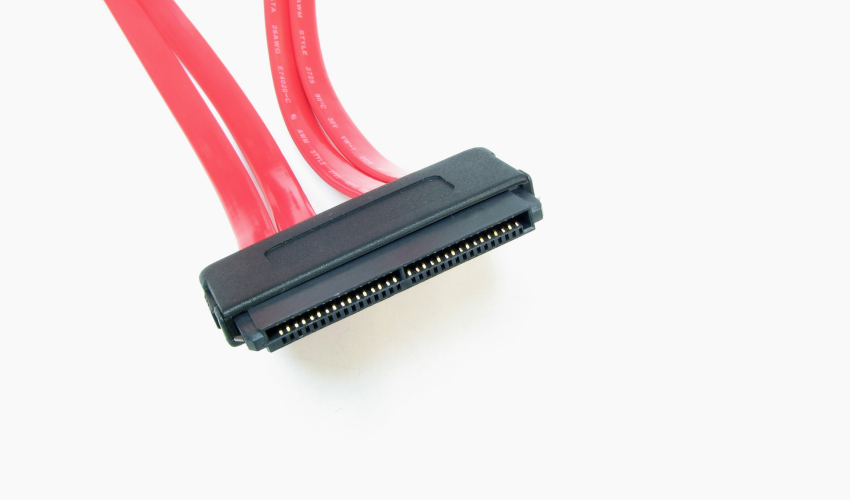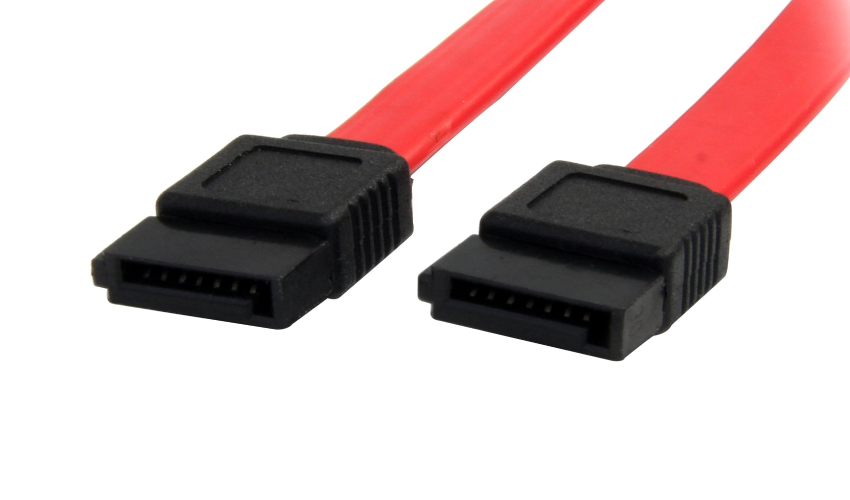In the dynamic world of storage solutions, SAS and SATA stand as stalwart contenders, each with unique merits. Beyond technical jargon lies a pivotal decision affecting speed, reliability, and affordability. This exploration goes beyond specs to decode their impact on our digital experiences.
Whether you’re a tech enthusiast or a novice user, this journey unveils the human aspect of choosing between SAS and SATA, offering insights for seamless storage decisions that align with individual needs and aspirations. Join us to uncover the right fit, bridging the gap between technology and its real-world implications.
Here is a detailed comparison between SAS Vs SATA
1. Understanding SAS (Serial Attached SCSI)

Ⅰ. Definition and Purpose:
- Serial Attached SCSI (SAS): A high-speed, serial communication protocol to connect storage devices such as hard drives and solid-state drives (SSDs).
- Purpose: Facilitates data transfer between the computer and storage devices, balancing performance and reliability
Ⅱ. Key Features and Advantages:
- Speed: Faster data transfer rates than SATA, crucial for demanding applications.
- Scalability: Supports multiple devices in a daisy-chain configuration, making it suitable for enterprise environments with evolving storage needs.
- Reliability: Incorporates features like error detection and correction, enhancing data integrity.
- Dual-Port Capability: Allows redundant paths, ensuring continuous data access even in connection failure.
Ⅲ. Typical Use Cases:
- Enterprise Storage: Commonly employed when performance and reliability are paramount.
- Mission-Critical Applications: Ideal for applications demanding quick and reliable access to large datasets, such as financial transactions or scientific computing.
- Server Environments: Widely used to connect high-performance storage to servers, ensuring efficient data handling.
Ⅳ. Considerations for Choosing SAS:
- Performance Requirements: Suitable for scenarios where high-speed data transfer is essential, making it a preferred choice for data-intensive applications.
- Budget Constraints: While SAS provides robust performance, its premium cost might be a consideration for smaller-scale deployments.
- Compatibility: Ensure that your hardware supports SAS connections and evaluate the compatibility with existing infrastructure.
- Future Expansion: Assess your storage infrastructure’s scalability needs to accommodate future growth effectively.
Also See: 10+ Best Data Recovery Software Tools
2. Exploring SATA (Serial ATA)

Ⅰ. Definition and Purpose:
- Serial ATA (SATA): A widely used interface connecting storage devices like hard drives, solid-state drives (SSDs), and optical drives to computer motherboards.
- Purpose: Provides a cost-effective and versatile solution for various storage needs in consumer and business environments.
Ⅱ. Key Features and Advantages:
- Affordability: SATA technology is cost-effective, making it an attractive choice for personal computing and budget-friendly storage solutions.
- Ease of Use: Simplified cabling and hot-swapping capabilities enhance user convenience, contributing to widespread adoption.
- Compatibility: Virtually every modern motherboard supports SATA, ensuring compatibility across various devices.
- Capacity Support: While initially designed for HDDs, SATA has evolved to support high-capacity SSDs, meeting the increasing demand for faster storage.
Ⅲ. Typical Use Cases:
- Consumer PCs: SATA is extensively used in desktops and laptops, offering an efficient and economical solution for everyday computing needs.
- Backup Storage: Suited for applications where high-speed data transfer is not critical, such as backup drives or secondary storage.
- Multimedia Applications: Ideal for storing media files, including photos, videos, and music, where the emphasis is on storage capacity rather than rapid data access.
Ⅳ. Considerations for Choosing SATA:
- Budget Constraints: SATA is a cost-effective solution that suits those seeking reliable storage without breaking the bank.
- Performance Requirements: If high-speed data transfer is critical, users may need to weigh the advantages of SATA against alternatives like SAS.
- Device Compatibility: Confirm that the storage devices you plan to use are SATA-compatible, ensuring seamless integration with existing hardware.
- Future Upgrades: Consider the scalability needs of your system, especially if you anticipate future upgrades that may demand higher-performance storage solutions.
Also See: Alternative for Google Storage on Whatsapp
Head-to-Head Comparison
1. Speed and Performance:
Ⅰ. SAS Capabilities:
- It boasts high data transfer rates, crucial for demanding enterprise applications.
- It offers faster rotational speeds and lower latency, enhancing overall system performance
Ⅱ. SATA Limitations:
- Generally, it has lower data transfer rates than SAS, making it less suitable for high-performance environments.
- Higher latency and rotational speeds may result in slower data access than SAS.
2. Scalability:
Ⅰ. SAS Scalability:
- Designed with scalability in mind, supporting the daisy-chaining of multiple drives.
- It is ideal for enterprise environments requiring seamless expansion of storage capacity.
Ⅱ. SATA Limitations:
- Limited scalability due to its simpler architecture makes it less suitable for large-scale storage solutions.
- It could be better suited for high-density storage configurations found in data centers.
3. Reliability and Redundancy:
Ⅰ. SAS Features:
- Implements advanced error-checking and correction mechanisms, ensuring high data integrity.
- It incorporates dual-port capability, providing redundancy and continuous access regardless of connection failures.regardless of connection failures.
Ⅱ. SATA Considerations:
- While reliable for general use, SATA may offer a different error detection and correction level than SAS.
- Single-port design may pose a risk in scenarios where uninterrupted data access is critical.
4. Cost:
Ⅰ. SAS Pricing:
- Generally, it comes at a higher price point due to its enhanced performance, reliability, and scalability features.
- Suited for environments where the benefits justify the higher upfront investment.
ⅠⅠ. SATA Affordability:
- Due to its cost-effectiveness, it is a popular choice for budget-conscious consumers and small-scale deployments.
- Provides a balance between performance and affordability, catering to a wide range of users with varying budget constraints.
Choosing the Right Connection for Your Needs
1. Considerations for Specific Use Cases:
Ⅰ. Enterprise Environments:
- Evaluate the demands of data-intensive applications, such as databases or virtualization, where SAS’s high-speed data transfer and scalability excel.
- Consider the importance of reliability and redundancy in mission-critical scenarios, favoring SAS for its dual-port capability and advanced error-checking features.
ⅠⅠ. Consumer Applications:
- Assess the budget constraints of individual consumers or small businesses, where SATA’s affordability and adequate performance may be more fitting.
- Consider the nature of data access needs—SATA can be well-suited for storing media files or general-purpose computing.
2. Future-Proofing Your Storage Solution:
Ⅰ. Scalability Planning:
- Anticipate future storage needs and choose SAS for environments where scalability is crucial, ensuring seamless expansion without compromising performance.
- Consider the potential growth of your data storage requirements and invest in a solution that aligns with long-term scalability goals.
ⅠⅠ. Compatibility and Standards:
- Stay abreast of industry standards and technology trends to ensure your chosen connection aligns with evolving hardware and software requirements.
- Opt for connections with a proven compatibility and interoperability track record, safeguarding against obsolescence.
3. Balancing Performance and Cost:
Ⅰ. Assessing Performance Requirements:
- Determine the specific performance needs of your applications, balancing the benefits of SAS’s high speed against SATA’s more budget-friendly options.
- Conduct a thorough analysis of the performance demands of your workloads to avoid overinvesting in features that may surpass your requirements.
ⅠⅠ. Total Cost of Ownership (TCO):
- Consider the upfront costs and ongoing expenses, such as maintenance and power consumption, to get a comprehensive view of TCO.
- Evaluate the trade-off between performance gains and budget constraints, ensuring that the chosen solution aligns with long-term financial considerations.
Real-world Examples
1. Case Studies of Successful Implementations Using SAS:
Ⅰ. Enterprise Data Centers:
- Large-scale data centers often leverage SAS for their storage infrastructure due to its high-speed data transfer rates and scalability.
- SAS facilitates the efficient handling of massive datasets, which is critical for enterprises dealing with complex computations and analytics.
ⅠⅠ. Financial Institutions:
- The redundancy features of SAS play a crucial role in maintaining data integrity in time-sensitive financial transactions.
- Banking and financial sectors rely on SAS for its reliability and dual-port capability, ensuring uninterrupted access to transactional data.
ⅠⅠⅠ. Scientific Research:
- Scientific research institutions utilize SAS in high-performance computing environments where rapid data access is essential.
- The dual-port capability and advanced error-checking mechanisms make SAS a preferred choice for handling vast data in research simulations.
2. Case Studies of Successful Implementations Using SATA:
Ⅰ. Personal Computing:
- SATA’s ease of use and compatibility make it a go-to choice for individual users seeking reliable and affordable storage options.
- Everyday consumers benefit from SATA connections in their desktops and laptops, providing a cost-effective solution for general-purpose storage needs.
ⅠⅠ. Small to Medium-Sized Businesses (SMBs):
- SMBs with moderate storage requirements find SATA a practical solution, balancing performance and budget considerations.
- SATA’s scalability supports small businesses’ growth, offering a reliable storage foundation without excessive costs.
ⅠⅠⅠ. Home Entertainment Systems:
- SATA is widely used in home entertainment systems for storing media files, including videos, photos, and music.
- The affordability of SATA makes it an accessible choice for consumers building media-centric setups without compromising performance.
Best Practices and Tips
1. Recommendations for Optimal Performance:
Ⅰ. Regular Firmware Updates:
- Ensure storage devices and controllers have the latest firmware updates to benefit from performance enhancements and bug fixes.
- Timely updates can address compatibility issues and optimize the communication between hardware components.
ⅠⅠ. Utilize High-Quality Cables:
- Invest in high-quality SAS or SATA cables to minimize signal interference and ensure reliable data transfer rates.
- Poor-quality cables can lead to performance degradation and connectivity issues, impacting the overall system efficiency.
ⅠⅠⅠ. Proper Drive Configuration:
- Configure drives according to workload requirements, considering factors like RAID configurations for redundancy or striping for performance.
- Tailor the storage setup to the specific needs of the applications to maximize overall system performance.
Also See: Best Way to Transfer file from PC to Iphone
2. Maintenance and Troubleshooting Tips:
Ⅰ. Regular System Checks:
- Implement routine checks for hardware health, using diagnostic tools to identify potential issues before they escalate.
- Regular maintenance helps prevent unexpected failures and ensures the longevity of storage components.
Ⅱ. Monitor Temperature and Cooling:
- Maintain optimal operating temperatures for storage devices by ensuring proper ventilation and cooling.
- Overheating can lead to performance degradation and hardware failures, so monitoring temperature levels is crucial.
Ⅲ. Backup and Redundancy Strategies:
- Implement robust backup strategies to safeguard against data loss in a hardware failure.
- Utilize redundancy features such as RAID configurations to enhance data integrity and provide failover support.
Ⅳ. Addressing Connectivity Issues:
- Troubleshoot connectivity issues promptly by checking cables and connectors and ensuring proper seating of storage devices.
- Regularly inspect physical connections to prevent data transfer interruptions caused by loose or damaged components.
Ⅴ. Collaborate with Vendor Support:
- Establish a relationship with the hardware vendors and leverage their support channels for assistance in case of persistent issues.
- Vendor support can provide valuable insights and solutions tailored to the specific storage hardware.
Conclusion
In the dichotomy of SAS vs. SATA, the choice hinges on individual needs and priorities. SAS stands tall in high-performance, scalable enterprise landscapes, offering redundancy and speed at a premium. Conversely, SATA emerges as the cost-effective champion, catering to consumers and small businesses with practical reliability.
The decision boils down to a delicate balance of performance requirements, budget considerations, and future scalability needs. Whether weaving through the intricacies of SAS for robust enterprises or embracing the simplicity of SATA for personal computing, the quest for the ideal storage connection ultimately echoes the nuanced symphony of individual preferences and system demands.


